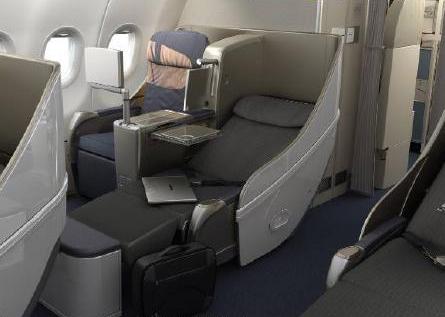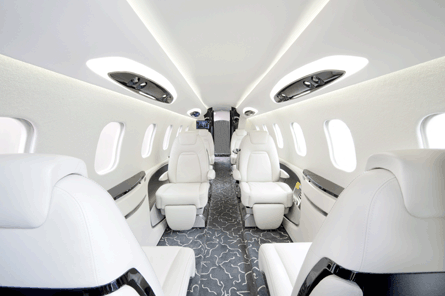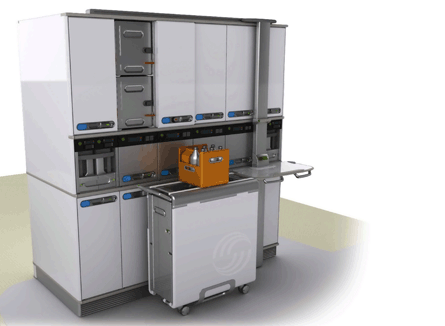Weight saving is critical in cabin interior design, in keeping with the overarching imperative to reduce fuel burn. However, obstacles arising from regulatory requirements, customer perceptions and issues of maintainability need to be overcome.
Past attempts to deploy lightweight composite materials in seats - the major driver of total cabin weight, ahead of galleys and in-flight entertainment - have been hampered by the fact that they are "extremely problematic" to certificate, says Airbus's head of aircraft interiors marketing Bob Lange.
"An aircraft seat has to go through deceleration testing and crash testing, and the behaviour of the composite material is harder to model than metallic materials, which means the testing becomes empirical - trial and error," says Lange. "The consequence is that the testing becomes very costly. You need to do more iterations to get the seat certificated. That's meant that the two strongest attempts that I've seen in the last 10 years to introduce composite seats have led to either the composites being taken out or the scope of commercialisation of the seat - and its market impact - being limited."
 |
|---|
© British Airways |
Customer perceptions also pose a challenge in seat design, to the extent that a seat's thickness is seen as a measure of its comfort. British Airways design executive Peter Cooke explains: "A very ergonomically designed seat doesn't have to have 4in [100mm] of foam, whereas if you showed that in a customer focus group they'd probably pick the thicker seat because it looks more comfortable." Many lightweight materials are not durable enough to last in service on long-haul flights, he adds.
TARGET WEIGHTS
Until recently a vogue for differentiating cabins through premium seating led some airlines to buck the weight-saving trend. "The weight of premium seats has in some case doubled, in some cases quadrupled," says Lange. "We have seen the weight of more sophisticated in-flight entertainment systems increasing [as] the service options that premium carriers are delivering to their customers have increased." However, the dramatic spike in oil prices last summer and the onset of recession gave even premium operators "pause for reflection", leading to "stronger assessments...of how a product will influence the airline's market share or generate revenues, rather than reacting as a kind of arms race to a competitor".
BA is targeting the heavy actuators deployed in adjustable motorised seats. One option is to replace such seats with hydraulically operated ones, though the technology is not yet cabin ready. Additionally, the carrier may look to replace solid dividing screens with translucent ones, or go a step further by breaking up cabins with light or fabric curtains instead of screens. It is also investigating increased deployment of composite panels in cabin furniture, although the need to satisfy flammability and smoke toxicity regulations stretches the timeframe.
"We'd love to go down the route of Kevlar carbonfibre type materials," says Cooke, citing innovations that have been achieved in design of Formula One cars and racing bikes.
 |
|---|
© Bombardier |
Weight saving through innovative material use has been prioritised by Bombardier Aerospace in its cabin design for its Learjet 85, a corporate jet with an all-composite airframe due to enter service in 2013. Bombardier has introduced new forms of thermal and noise insulation, as well as seeking to reduce the level of foam deployed in seats.
Additionally, the Learjet 85 has single-ply side panels strong enough to eliminate the need for a skeleton within, an innovation intended to simplify assembly and manufacturing as well as save weight. Similar imperatives led the airframer to deploy a double-club seating configuration, allowing components to be switched between different areas of the cabin and symmetric tools and repeated patterns to be used in design and manufacture.
Meanwhile, the possibility of reducing weight in catering equipment is being explored by Airbus via a project named Spice (Space Innovative Catering Equipment). "It's something where the standards we have today haven't moved forward since the 1960s," says Lange. "They're becoming blocking points to further innovation. The common denominator of today's galleys is the catering trolley - they weigh 20kg [44lb] each when they're empty and 100kg when they're loaded. You've got anything between 10kg in a single-aisle aircraft and 80kg or more in an A380, and all of this weight is deadweight, which for most of the flight is not actually offering any function."
Within Spice, Airbus has mooted replacement of catering trolleys with "lightweight low-cost boxes and foldable carts for service", alongside other measures. Cumulatively, these innovations could allow an airline to add up to 11 seats in the cabin of a typical widebody and eliminate up to 20% of the weight of galley systems, says the airframer. Airbus will offer Spice for new aircraft and as a retrofit from "early next decade".
While BA is considering replacing disposable catering products with rotable products, Cooke warns that there are marketing priorities. "We're a premium airline," he says. "We like to make sure that the feel of a product is of a quality. Having said that, we know there are some products out there [applying] new ceramic technology that is lightweight."
Cooke is confident that as technology advances it will become easier to achieve weight reductions without compromising "look and feel". In seeking to stay abreast of developments BA works in conjunction with the small pool of suppliers with sufficient scale to deliver the volumes it requires to standardise across its fleet. "I think it's the airlines that tend to push the innovation rather than the suppliers [but] it's changed a bit recently," says Cooke. "Suppliers are now getting on board with weight-saving opportunities."
 |
|---|
© Airbus |
LIGHT ENTERTAINMENT
A natural lag exists between developments in ground-based technology and their application in the air, for regulatory and economic reasons. "The particularity of aircraft cabins is that compared with ground-based uses we have relatively small volumes," says Lange. "We don't go to Dupont and buy tens of thousands of tonnes of plastics. We buy a few tonnes. So, a lot of it is not just the technical capability of the material, but its economic readiness."
Despite the lag, the pace of change in the area of in-flight entertainment has been rapid. "I think the entertainment that we offer is leaps ahead of where it was almost 10 years ago, where we were still doing pull-down screens," says Cooke. "But the expectation with respect to connectivity, iPods, etc, is still relatively difficult to achieve. Things like IFE screens, entertainment screens, etc, are becoming much thinner now, much lighter, but due to technological constraints they're not as thin and light as your standard laptop."
However, a major breakthrough may be imminent. "Once the ability is there to get full connectivity and we're able to transmit our entertainment from the ground, not carry it on the aeroplane, then the opportunity's there for weight saving," says Cooke. "It's not far off."
In Lange's view IFE represents "the hardest part of the cabin to design for", partly because of the high expectations generated by the consumer goods market. There are also technical challenges attending the requirement to deliver services to a high concentration of people in a small space, at levels of higher service reliability higher than those that prevail on the ground. It is not, after all, easy to simply replace a faulty IFE screen during a long-haul flight.
"A European airline told me about a year ago that the maintenance cost of their in-flight entertainment was equivalent to that of a jet engine on one of their single-aisle aircraft," says Lange. "The IFE is the most expensive system on the aircraft after the engine, and we're seeing an interesting period of crossover in technologies. Among the airlines offering a lower-cost product, we've seen a proliferation of portable solutions developed essentially from the ground-based market [which] can be used in aircraft, but with limited functionalities."
According to Lange, the migration of technology from "the portable world into the aircraft embedded world" has been accompanied by a decline in the real cost of higher-end systems, reflecting the potential to generate ancillary revenue by charging for their use. "What we're convinced about Airbus is that there is a category of in-flight entertainment that offers on-demand video and connectivity without the level of choice of a high-end system, but at a significantly lower price point," he says. "A ballpark figure would be a quarter."
Thin, flat-panel OLED (organic light-emitting diode) televisions are likely to find application in cabins, in Lange's view. "It provides a weight saving, but for aeronautical use it needs to be robust and it needs to be affordable," he says. "A lot of our technology watch is about picking the timing. There will be a time when OLEDs will be used for displays for the in-flight entertainment system, but before that we'll be introducing them in the passenger display signs in the panel above your head. We're driven, like the whole industry, by safety, which means that when we identify promising technology, then we put it through a qualification loop, which sometimes takes a year or two and sometimes can take 10."
Source: Flight International























